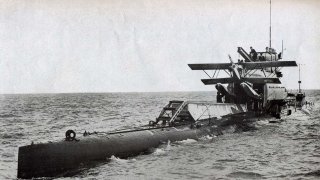M-Class Submarine: Why Does This Sub Have Battleship Guns?
Despite having the firepower of a battleship, the M-class didn’t work out for the Royal Navy. Here’s why.
The British M-class was introduced at the tail end of World War I. They were originally intended to be used for coastal bombardment or as submarine monitors. They were among the largest submarines in the Royal Navy when they were laid down. Though the class was armed with torpedoes, this was not their main armament.
As originally intended, the first of their class, the M3, was equipped with an enormous 12-inch naval gun. This foot-in-diameter gun was manufactured for British battleships in the late 1890s, but due to a lack of funding were never widely used, though Italy did mount the gun for use in some of their ships. Japan successfully used original and license-produced guns during the Russo-Japanese war, where they were used in the first all-steel naval engagement.
During the M-class manufacturing phase, the role they would play was reimagined. Rather than coastal bombardment, the M-class would take advantage of their underwater ability to prey on merchant shipping. Instead of hunting ships underwater with torpedoes, the M-class would surface unexpectedly near enemy ships and fire its naval gun at the enemy. At shorter ranges, the gun would have a flat trajectory, simplifying aiming. It was assumed that a merchant ship would not be able to survive a hit from the 850-pound shell the 12-inch gun fired.
The drawback to the deck-mounted naval gun was that the first shot it fired would have to either sink or significantly damage whatever ship it targeted, as the gun could not be reloaded underwater. Aiming was done with a simple bead sight that was viewed through a periscope.
The M1, the only hull of the M-class to carry a deck gun, leaked badly. Corrosive saltwater damaged the barrel of the gun during test firing and the M1 was never involved in combat-related duties. Post-war, the M1 was struck by a Swedish ship during a training exercise in the English Channel. The blow was enough to tear the main gun from the hull, which quickly flooded, sinking the submarine, with all hands lost.
Refitted
After the loss of the M1, the other two M-class submarines were stripped of their deck guns and repurposed. The M2’s empty gun space was converted into a small watertight aircraft hangar. A small reconnaissance seaplane, a Parnall Peto, had folding wings and was stowed in the space. The Peto was unarmed and used as an airborne observation post to increase the lookout distance targets could be seen at. The M2 had been equipped with a crane to lift the small plane off the deck and into the water and for recovery, but this was later abandoned in favor of a compressed air catapult.
The M2 sank in 1932, also in the English Channel. The likely cause was accidental flooding inside the hangar which could have been caused by the stern hydroplanes becoming unresponsive. The M2 sank, with all hands lost.
The third of the class, the M3, was unsuccessfully converted into a mine-laying submarine. A large floodable superstructure was mated to the hull deck and filled with mines. Due to the added weight of the mines and compartment, handling was both slow and dangerous, and the M3 was scrapped in 1932.
Despite having the firepower of a battleship, the M-class ended up being more dangerous to their crews than to the enemy.
Caleb Larson holds a Master of Public Policy degree from the Willy Brandt School of Public Policy. He lives in Berlin and writes on U.S. and Russian foreign and defense policy, German politics, and culture.
Image: Wikimedia

